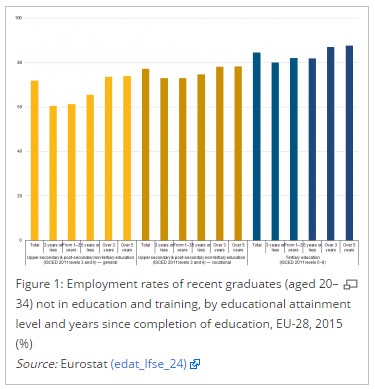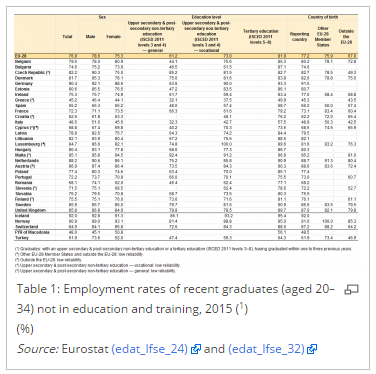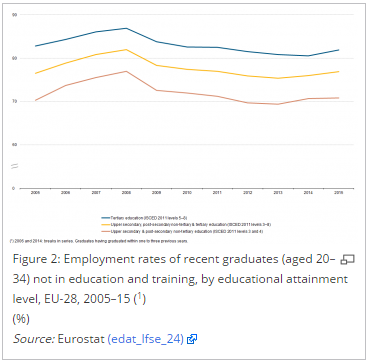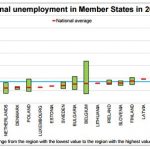What is the employment rate of young people in EU?

Below is an overview of European Union (EU) statistics related to the employment rates of young people (those aged 20–34 years) who have recently graduated from either upper secondary or tertiary levels of education (as defined by the international standard classification of education (ISCED)). It provides information on the transition from education to work and analyses the access to the labour market among recent graduates (those who have graduated within the last one to three years).
Main statistical findings
Employment rates of recent graduates
The data presented in this article refers to ‘graduates’ in a broad sense of the term, namely people having left education and training with at least an upper secondary level of educational attainment (ISCED 2011 levels 3 to 8).
A tertiary education or a vocational education increases employment opportunities
Figure 1 presents EU-28 employment rates for recent graduates (aged 20–34) by level of educational attainment. It reveals that the highest employment rates (for people not in education or training alongside their employment) in 2015 were recorded for those who had graduated with a tertiary education (ISCED levels 5–8), while lower employment rates were recorded for those with an upper secondary or post-secondary non-tertiary education (ISCED levels 3 or 4). Note that recent graduates with a vocational upper secondary or post-secondary non-tertiary education (hereafter referred to as ‘vocational graduates’) systematically recorded higher employment rates than those with a general upper secondary or post-secondary non-tertiary education (hereafter referred to as ‘generalist graduates’). As such, it would appear that apprenticeships and other kinds of education programmes that equip students with the knowledge, know-how, skills and/or competences required for a particular occupation increase the likelihood of recent graduates being able to find a job.
It should be noted that the indicator ’employment rate of recent graduates’ presented in this article concerns recent graduates (in other words, those who have graduated within the last one to three years) meeting two criteria, namely:
- being in employment, and;
- not in any further (formal or non-formal) education or training (during the four weeks preceding the survey).
The proportion of recent graduates who are undertaking education or training alongside their employment – not covered by the above-mentioned indicator – varies depending on their level of educational attainment and this may influence the employment level of recent graduates.
The other aspect clearly apparent from Figure 1 is the increase in recent graduate employment rates as a function of the time spent since the completion of education. Again it should be noted that this may reflect falling participation in education and training alongside employment as the time since graduation increases, and not just increases in the chances of employment.
For all three groups of educational attainment, the lowest employment rates for graduates aged 20–34 were recorded for those who had left education or training during the three previous years, which reflects, to some extent, the initial difficulties that recent graduates have in finding their first job.
The employment rates at EU-level for graduates having left education or training during the last three years shows that for those with a tertiary education it was 79.9 % in 2015, while the corresponding rate for vocational graduates was 6.9 percentage points lower. By contrast, the employment rate for generalist graduates was considerably lower, at 60.5 %, or some 19.4 percentage points below the corresponding figure for tertiary graduates.
Skills mismatch: tertiary graduates may take jobs for which they are over-qualified
Some of the difference between generalist and tertiary graduates may be linked to tertiary graduates deciding to take jobs for which they were over-qualified in order to get into the labour market, thereby boosting the employment rate for tertiary graduates while at the same time lowering employment rates for other graduates. This may be particularly important in those cases where labour market demand is subdued, for example, following the onset of the global financial and economic crisis.
Benchmark target for ET 2020
While each EU Member State remains responsible for its own education and training system, the strategic framework for education and training 2020 (ET 2020) is designed to address common challenges, while providing a forum for the exchange of best practices and sharing evidence of policy initiatives within this domain that have been a success.
ET 2020 sets eight education and training benchmarks to be achieved in the EU-28 by 2020. Among these, one target is specifically related to the employment rate of recent graduates. It was introduced in May 2012 and aims to see the share of employed graduates (aged 20–34 with at least upper secondary education attainment and having left education one to three years ago) reaching 82.0 %.
It is important to note that the target employment rate for recent graduates encompasses both those leaving education and training with at least an upper secondary or post-secondary, non-tertiary qualification (ISCED 2011 levels 3 and 4) with either general or vocational orientations, and those leaving with a tertiary education qualification (ISCED 2011 levels 5–8).
Employment rates for recent graduates in Malta and Germany were approximately twice as high as those recorded in Greece or Italy
Table 1 provides a detailed picture of the latest information available for employment rates of recent graduates. It is based on graduates (aged 20–34) who had completed their education or training between one and three years prior to the survey being conducted. In 2015, the EU-28 employment rate for this subpopulation was 76.9 %, ranging from highs of 90.4 % in Germany and 95.1 % in Malta to lows of 45.2 % in Greece and 48.5 % in Italy; a lower rate was also recorded in the former Yugoslav Republic of Macedonia (48.0 %). Aside from Germany and Malta, there were seven additional EU Member States where the employment rate of recent graduates was above the 82.0 % benchmark target set by the ET 2020: the Netherlands, Austria, Sweden, the United Kingdom, Luxembourg, the Czech Republic and Lithuania.
Development over time
Employment rates of recent graduates peaked in 2008
In keeping with the remainder of the population, recent graduates have been affected by the global financial and economic crisis. Figure 2 shows that EU-28 employment rates of recent graduates climbed during the period 2005–08, both for those graduating with an upper secondary or post-secondary non-tertiary education, as well as those graduating with a tertiary level of educational attainment. Employment rates peaked at 77.0 % for the former and 86.9 % for the latter in 2008.
With the onset of the financial and economic crisis, there followed a period of six consecutive annual reductions in employment rates of recent tertiary graduates, but in 2015 this rate showed signs of recovery (up by 1.4 percentage points compared to 2014). By 2015, the EU-28 employment rate for recent tertiary graduates stood at 81.9 % ( percentage points lower than its relative peak in 2008).
Turning to recent graduates from upper secondary or post-secondary non-tertiary education, the EU-28 employment rate was 69.4 % in 2013 (which was 7.6 points lower than in 2008). By contrast, data for 2014 saw an upturn for this subpopulation, as their rate rose by 1.3 points to 70.7 % and remained rather stable in 2015 at 70.8 %.
In 2015, the gap in employment rates between recent tertiary graduates and recent upper secondary or post-secondary non-tertiary education graduates was 11.1 percentage points, which was larger compared to the situation in 2008 (9.9 points).
The increase in the employment rate of recent graduates through to 2008 was cancelled out by the economic and financial crisis …
There was almost no change in the EU-28 employment rate over this period (76.5 % in 2005 compared with 76.9 % in 2015). This reflects the sluggish economic recovery post-2008 which cancelled out any gains made during the first four years of the period under consideration (as previously shown in Figure 2).
… with a particularly large impact in those EU Member States most affected by the crisis
The impact of the crisis on the access to the labour market of graduates was particularly pronounced in Greece and Italy, where the employment rate of recent graduates fell by almost 15.0 percentage points during the most recent 10-year period for which data are available. There were also considerable reductions in Spain, Portugal and Ireland — all of which were amongst those Member States most seriously affected by the crisis — as employment rates of recent graduates fell by 10.0 points or more. It is interesting to note that back in 2005, Ireland and Portugal each recorded employment rates for recent graduates that were above the 82.0 % ET 2020 benchmark target.
Of the nine EU Member States that recorded employment rates for recent graduates in 2015 that were above the 82.0 % benchmark target, Germany and Sweden registered the most sizeable increases between 2005 and 2015, with gains of 10.8 percentage points and 6.5 points respectively. By contrast, although the latest employment rates for recent graduates in the Netherlands, the United Kingdom, Luxembourg and the Czech Republic remained above the 82.0 % target, each of these recorded reductions between 2005 and 2015.
There were relatively high increases in employment rates of recent graduates in some Member States
In 2005, only five EU Member States — Bulgaria, Poland, Croatia, Italy and Greece — had employment rates for recent graduates that were below 70.0 %, while the remaining Member States each reported rates of at least 72.1 %. Between 2005 and 2015, employment rates of recent graduates rose by as much as 10.8 percentage points in Germany and 10.1 percentage points in Poland, although this was from a relatively low starting point (67.3 %) for the latter.
Gender differences
Recent male graduates in the EU were more likely to find work than their female counterparts
In 2015, the EU-28 employment rate of recent male graduates (78.6 %) was somewhat higher than the rate recorded among recent female graduates (75.3 %). Some of these gender differences may be explained by the nature of studies (fields) that are typically followed by the two sexes (for example, a higher proportion of science and technology students tend to be male) and by differences in labour market demand for graduates with different skills.
The largest gender gaps for EU-28 employment rates of recent graduates were recorded in 2005 and 2007. However, with the onset of the financial and economic crisis, there was a rapid reduction in the gap between male and female rates. In 2009, the employment rate of recent male graduates fell by 4.8 percentage points, compared with a reduction of 2.6 percentage points among recent female graduates. This was short-lived as the gender gap widened again in 2010 and remained within the range of 3.3–4.5 percentage points (in favour of young male graduates) during the period 2010–15.
The gender gap in employment rates of recent graduates was present in 22 of the EU Member States and was most pronounced in the Czech Republic and Romania where the employment rates of recent male graduates were 15.3 and 12.1 percentage points higher than those for women; an even larger gender gap was recorded in Turkey (21.6 points).
By contrast, employment rates for recent female graduates were slightly higher than those for their male counterparts in Sweden, Finland, Croatia, Cyprus and France, with a difference between the sexes of no more than 2.4 percentage points, a gap that rose to 2.9 points in Belgium; there was also a gap in favour of women in Switzerland, Norway and the former Yugoslav Republic of Macedonia (respectively 1.7, 4.1 and 5.7 points difference between the sexes).
– Data extracted in July 2016. Most recent data: Further Eurostat information, Main tables and Database. Planned article update: June 2017.
Read the full article at: Employment rates of recent graduates
This article is one of a set of statistical articles forming part of an online publication on education and training; it provides a complement to information on early leavers from education and training and young people neither in employment nor in education or training.
Source: Eurostat
































